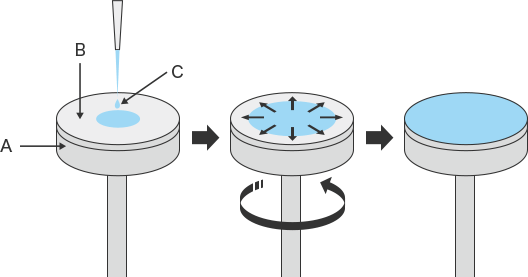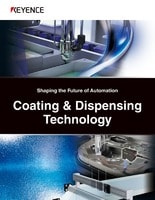Spin Coating
Overview of spin coaters
Spin coaters, or spinners, are coating devices that use the centrifugal force of rotation. Spin coaters can make thin and uniform coats on flat and smooth targets. These devices are used in a wide range of applications including surface processing and resist coating on semiconductor wafers, coating on optical media, and coating primer or photochromic solution onto lenses.
- Coating with a spin coater
-

- A. Rotating stage
- B. Target surface
- C. Coating fluid
The coating fluid is dropped at the center of the target and the stage starts rotating. As the rotation accelerates, the centrifugal force is applied to the coating fluid, spreading the fluid over the entire surface to make a coating film. The thickness of the film depends on the fluid viscosity, rotation speed of the target, rotation start acceleration, and ventilation, which affects drying speed.
One of the disadvantages of spin coaters is the loss of material because excessive fluid is dispersed beyond the target by the centrifugal force of the rotation.
Typical spin coaters have enclosed rotating and dropping mechanisms, or have a lid that is closed during coating for the purposes of controlling the drying speed through ventilation, and preventing dispersion outside the equipment while also preventing entry of foreign particles.
Although the basic principle of the equipment has not changed in several decades, spin coaters are available with various specifications and functions. This includes a variety of target sizes, weights, and materials, as well as the ability to control rotation speed manually or automatically, or to drop fluids automatically.






